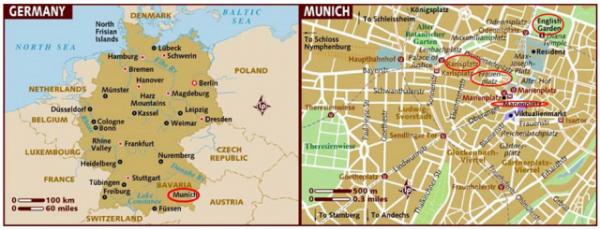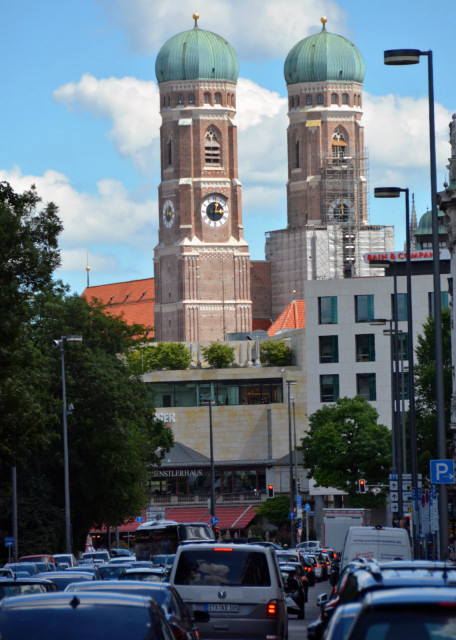2017-07-01

【Aiden in English】
German culture has seen significant changes in modern history. Having been the antagonist in numerous conflicts, the country has taken steps toward reform. Ironically, the rest of the world has yet ot shift its focus on Germany. Recently, on a separate trip, I had the opportunity to experience a glimpse of German culture in Berlin. However, I am back for more, this time a more personal look at Germany. Munich is surprisingly strong and sound as a city despite losing ninety percent of its historical buildings to bombs in World War II. Much of the heritage has been preserved. Combined with modern culture, most of the historical Munich has now been transformed into shops and restaurants. Locals, as well as tourists, walk the streets in search of something that catches their eyes. However, Mom and I were not here to shop. Munich is one of the largest cities in Europe, with a population of around 1.5 million residents. Furthermore, tourists come and go throughout the year, regardless of the weather. Therefore, it's no surprise that Munich has risen to the top of the cities I've seen so far. In a brief description of why Munich somewhat resembles Rome, cities with rich histories and integrated modern civilizations, resulting in spectacular cultures and unique aspects, Rome and Munich truly mirror each other almost identically. Munich only slightly differs from its historic roots because World War II caused more than property damage. However, the Germans quickly rebuilt the city, restoring much of what it had lost, which is understandable due to their legendary mechanical skills. Like the Go Vegan Festival, we have left many parties and fairs on the streets for no apparent reason or purpose. The roads are what set Munich apart from other cultural cities worldwide. The fact that random carnivals can just be generated is a sign of a tremendous cultural step. People were unafraid to be themselves, riding bikes, smoking, and drinking beer on the street. Granted, some aren't good hobbies, but most people seemed healthy enough. However, every city has not yet escaped its roots. Like nearly all large European cities, Munich had a church around every corner. Truthfully, the churches are nothing compared to Notre Dame in Paris or St. Peter's Basilica in Vatican City. Nevertheless, its people and the atmosphere on the streets are what set it apart. The contrast between the chaos on the roads and the quiet nature of the churches highlights two distinct aspects of Munich. These two sides can be found in many places. For example, the plaza with the food market and music had a backdrop of medieval statues and ancient fountains: old, chiseled pillars and bygone arches surrounded parks, where people rushed through the trees. Essentially, wherever people looked, they could see the two sides of Munich. Much like the two sides of the coin, one could not exist without the other. 【红霞译】
在当代历史上,日尔曼文化发生了翻天覆地的变化,德国曾几度成为世界公敌,如今正力求悔过自新。滑稽的是,全球其它国家依旧无法改变对日尔曼民族的看法,最近一回我初访柏林,多少能感受到这点。然而当我今年重返这片土地,想必对德国会有一个更加深入的了解。 尽管第二次世界大战摧毁了慕尼黑“僧侣城”百分之九十的古迹建筑,但这座城市却以惊人之举重整家园,从而使许多文化遗产得以保留下来。老城业已注入现代生活气息,大多数繁华地带挤满了商家店铺,当地人也伴随游客们华尔兹节奏曼舞大街小巷自寻乐趣,不过我和妈妈没想买啥东西。慕尼黑算作欧洲人口密度比较集中的地方,大约有一百五十万居民住在这里,何况一年四季无论天气冷暖,到此一游的观光客川流不息,难怪慕尼黑很快成为我所走过的都市中出类拔萃的佼佼者。
之所以给予高度评价无非在于,慕尼黑让我不由得想起罗马,两座城市历史悠久,现代文明洗礼又让原本辉煌强盛的民族文化和别具特色的地域风貌大放异彩,在这方面彼此发展得竟然非常相像,只不过二战才使慕尼黑透出稍有迥异的历史根基,远不止财产损失。好在德国人很快振兴,凭借祖传的机械技能,竭力让自己从战后废墟中重新崛起。
我们所到之处五花八门的聚会庆典层出不穷,像“素食节”就是其中一例,街头巷尾充斥各种活动的确让慕尼黑成为天下盛开的一朵奇葩。事实上,随性即兴的狂欢方式标志着一种极佳的生活状态,人们无拘无束,满大街骑单车抽香烟喝啤酒,千万别误解,有些嗜好未必算得上好习惯,但多数人看起来挺健康的。 然而,历史定会给各地打下不可磨灭的烙印。慕尼黑像欧洲其它名城一样,每个角落都建有教堂,说句实在话,这里任何一座都无法与巴黎圣母院或者梵蒂冈圣彼得大教堂相媲美,不过倒自然而然地把行人及慕尼黑赋予双重特色,并且反映到老城内外,譬如:广场上前面搭满吃货地摊唱歌舞台,后面矗立中世纪雕像古式喷泉;公园里穿梭林中之人被旧石柱和老拱门所包围,基本上无论你走到哪里,都能亲眼目睹慕尼黑动静两种状态,正如硬币两侧,谁都离不开对方。 Today in History(历史上的今天):
2017: Munich, the Village of A Million DEU(德国慕尼黑·百万人庄) 2017: Munich, the Secret Capital of Germany(德国慕尼黑·隐形首都) 2017: Munich, the World City w/ Heart DEU(德国慕尼黑·爱心之都) 2016: Moscow, the Third Rome of Russia(俄罗斯莫斯科·第三罗马)
2016: Moscow Red Square, Russia(俄罗斯莫斯科·红场)
2016: Moscow Kremlin, Russia(俄罗斯莫斯城·克里姆林宫) 2015: Mdina, the Medieval Capital of Malta(马耳他姆迪纳·中世纪古都) 2015: Capital Valletta, Malta(马耳他首都湾谷城) 2015: Colonized Nation of Europe, Malta(欧洲本土殖民地马耳他) 2014 World Cup—USA vs. Belgium(美国对比利时世界杯足球赛)  Brienner Straße, One of Four Royal Avenues Brienner Straße, One of Four Royal Avenues
(高贵大街·四条皇道之一 07-01-2017) 
DeutscheJagd- undnd Fischereimuseum (德国狩猎与捕鱼博物馆 07-01-2017)  Der Ring @ the Charles Hotel Der Ring @ the Charles Hotel
(自由人酒店·圆环 07-01-2017) 
Frauenkirche (圣母教堂)

Only One Window Visible @ Frauenkirche (圣母教堂·唯一看得见的窗户 07-01-2017)
 Abtei St. Bonifaz (虔诚圣徒修道院) Abtei St. Bonifaz (虔诚圣徒修道院)
 Nave of Abtei St. Bonifaz Nave of Abtei St. Bonifaz
(虔诚圣徒修道院·中殿 07-01-2017)  Theatinerstraße (戏剧教堂大街 07-01-2017) Theatinerstraße (戏剧教堂大街 07-01-2017)

Theatinerkirche St. Kajetan (剧院教堂 07-01-2017)

High Altar of Theatinerkirche St. Kajetan (剧院教堂·高坛 07-01-2017)
 Odeonsplatz (音乐厅广场 07-01-2017) Odeonsplatz (音乐厅广场 07-01-2017)

Sitzender Keiler @ Hirmer (迷人男装店《坐着的野猪》 07-01-2017)  Diana Pavilion & Fountain @ Hofgarten Diana Pavilion & Fountain @ Hofgarten
(王宫花园·神圣亭与喷泉 07-01-2017) 
Chinese Pagoda @ Englischer Garten (英国公园·中国宝塔) 
Neues Rathaus @ Marienplatz (圣母广场·新市政厅 07-01-2017)  Veggie Promoter @ Marienplatz Veggie Promoter @ Marienplatz
(圣母广场·蔬菜倡导者)
 Paulaner's Wirtshaus & Biergarten Paulaner's Wirtshaus & Biergarten
(迷你酒馆与啤酒园 07-01-2017)  Lunch @ Paulaner's Wirtshaus & Biergarten Lunch @ Paulaner's Wirtshaus & Biergarten
(迷你酒馆与啤酒园·午餐 07-01-2017)  Restaurant Ratsheller (市政厅地窖餐厅) Restaurant Ratsheller (市政厅地窖餐厅)
 Dinner @ Ratskeller Dinner @ Ratskeller
(市政厅地窖餐厅·晚餐 07-01-2017)  市政厅地窖餐厅·煎饼汤、烤美味香肠、德国猪肘与迷你酒馆的三明治 市政厅地窖餐厅·煎饼汤、烤美味香肠、德国猪肘与迷你酒馆的三明治
Crosslinks(相关博文): Germany(出游德国)
Europe(欧洲掠影) 8th Grade(初中三年级) |
